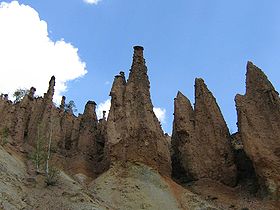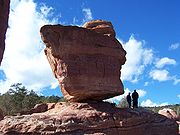
Rock (geology)
Background Information
SOS Children made this Wikipedia selection alongside other schools resources. A quick link for child sponsorship is http://www.sponsor-a-child.org.uk/
In geology, rock is a naturally occurring aggregate of minerals and/or mineraloids. The Earth's lithosphere is made of rock. In general rocks are of three types, namely, igneous, sedimentary, and metamorphic. Petrology is the scientific study of rocks.
Rock classification

Rocks are classified by mineral and chemical composition, by the texture of the constituent particles and by the processes that formed them. These indicators separate rocks into igneous, sedimentary and metamorphic. They are further classified according to particle size. The transformation of one rock type to another is described by the geological model called the rock cycle.
Igneous rocks are formed when molten magma cools and are divided into two main categories: plutonic rock and volcanic. Plutonic or intrusive rocks result when magma cools and crystallizes slowly within the Earth's crust (example granite), while volcanic or extrusive rocks result from magma reaching the surface either as lava or fragmental ejecta (examples pumice and basalt) .
Sedimentary rocks are formed by deposition of either clastic sediments, organic matter, or chemical precipitates ( evaporites), followed by compaction of the particulate matter and cementation during diagenesis. Sedimentary rocks form at or near the Earth's surface. Mud rocks comprise 65% ( mudstone, shale and siltstone); sandstones 20 to 25% and carbonate rocks 10 to 15% ( limestone and dolostone).
Metamorphic rocks are formed by subjecting any rock type (including previously-formed metamorphic rock) to different temperature and pressure conditions than those in which the original rock was formed. These temperatures and pressures are always higher than those at the Earth's surface and must be sufficiently high so as to change the original minerals into other mineral types or else into other forms of the same minerals (e.g. by recrystallisation).
The three classes of rocks: the igneous, the sedimentary and the metamorphic — are subdivided into many groups. There are, however, no hard and fast boundaries between allied rocks. By increase or diminution in the proportions of their constituent minerals they pass by every gradation into one another, the distinctive structures also of one kind of rock may often be traced gradually merging into those of another. Hence the definitions adopted in establishing rock nomenclature merely correspond to selected points (more or less arbitrary) in a continuously graduated series.
Coloration

Iron oxides and carbonates play a large part in many sedimentary rocks and are especially important as coloring agents. The red sands and limestones, for example, which are so abundant, contain small amounts of iron(III) oxide ( hematite), which in a finely divided state gives a red hue to all rocks in which it is present. Limonite and goethite, on the other hand, makes rocks yellow or brown; manganese oxides, asphalt and other carbonaceous substances are the cause of the black colour of many sediments. Bluish tints result sometimes from the presence of phosphates or of fluorite; while green is most frequently seen in rocks which contain glauconite or chlorite.
Impact on society
Rocks have had a huge impact on the cultural and technological advancement of the human race. Rocks have been used by Homo sapiens and other hominids for millions of years. Lithic technology marks some of the oldest and continuously used technologies. The mining of rocks for their metal ore content has been one of the most important factors of human advancement. Humanity's advancement has been decided by the kind of metals available from the rocks of a region. The prehistory and early history of civilization is classified into the stone age, Bronze Age, and Iron Age. Rocks have been and continue to be used to construct buildings and infrastructure. When so used, they are dimension stone.

